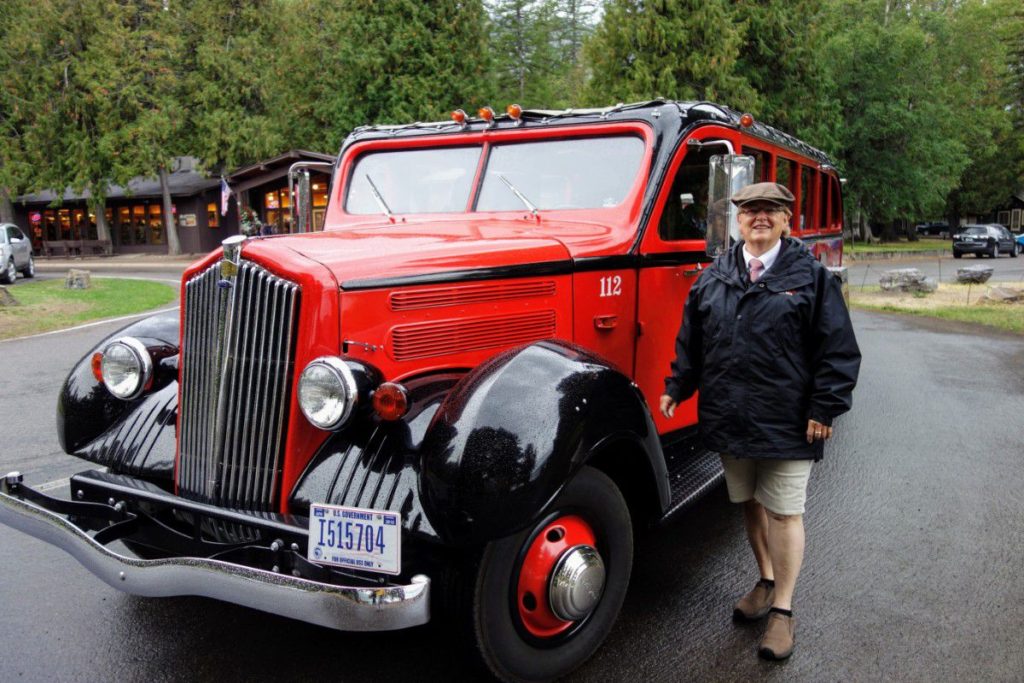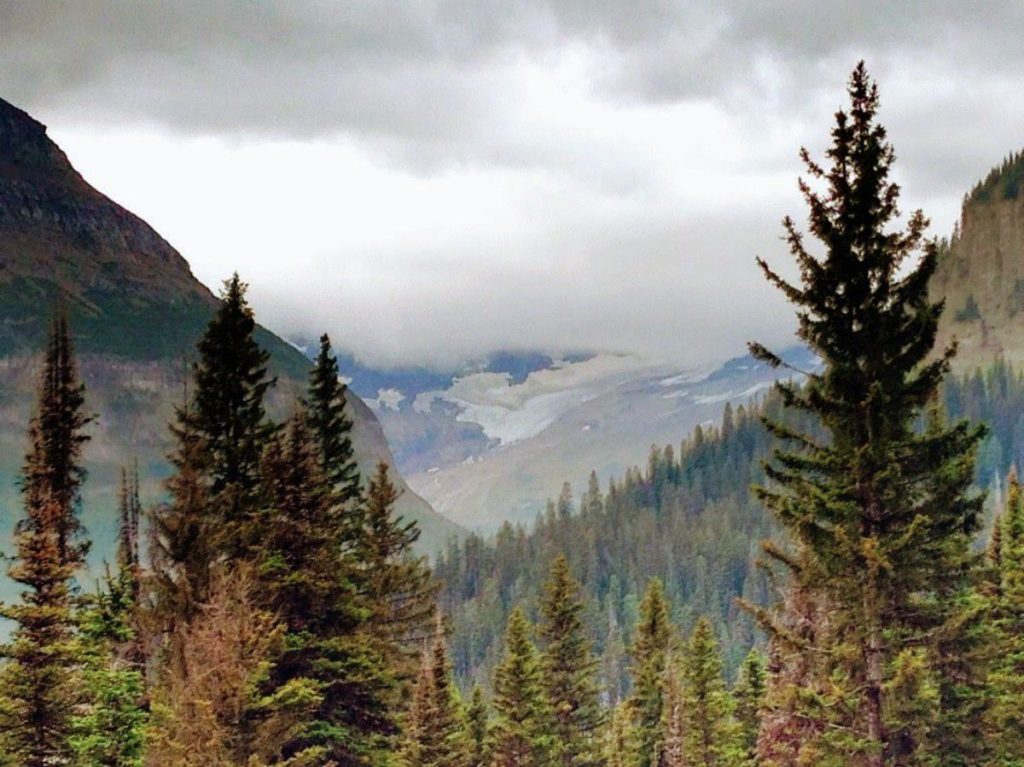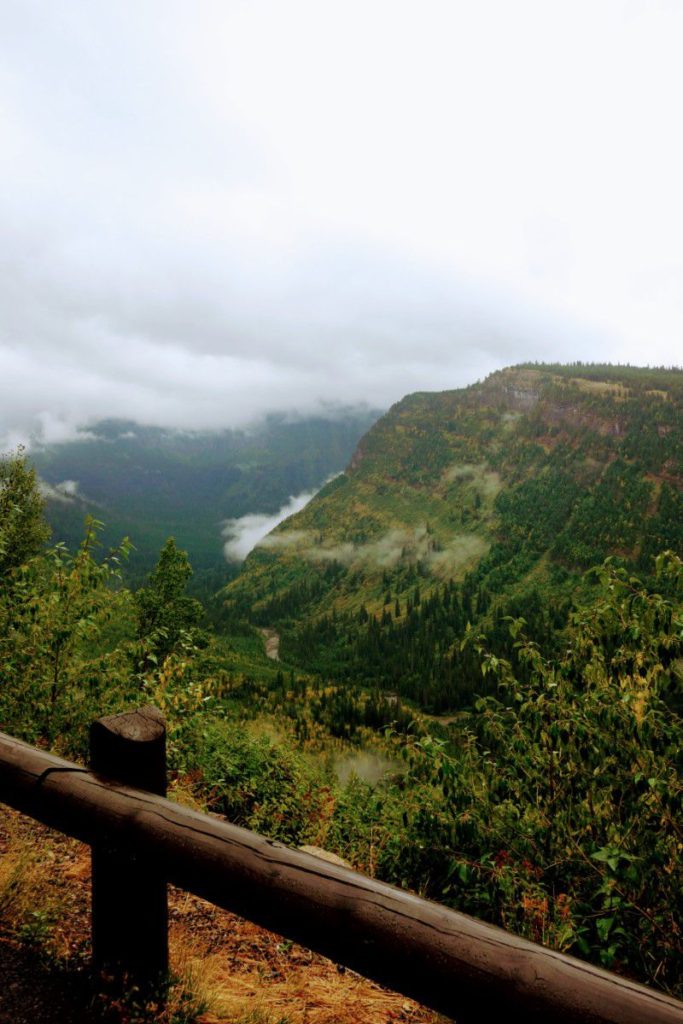On our one-day trip to Glacier National Park, we used a Red Bus Tour to get a comprehensive overall look at the park. I can’t recommend enough a tour like this if you have limited time, we really enjoyed it.

But if you have more time to explore, there is a lot more that Glacier has to offer. Let’s look at all the things you can do on your trip to Glacier National Park.
History
First, let’s cover a brief history of the park. What came as a surprise on my visit is that there are not a ton of glaciers in Glacier National Park. At least not so much anymore–the park is down from 150 glaciers in 1850 to 25 active glaciers today. It’s commonly accepted that all of the glaciers will be gone by 2030. The name really comes from the fact that the park’s mountains and valleys were gouged out by glacial action during the last ice age.

These mountains were originally inhabited by the Blackfeet and Flathead Native American nations before ceding the land to the United States in 1895. Around this time, more white explorers began to prowl around, including hunter George Bird Grinnell. It was Grinnell that first referred to the park as “The Crown of the Continent” in his efforts to preserve this area as a national park. Partly due to his influence, the park was signed into national protection by President Taft in 1910.
Consequently, the 1910s saw the building of a railway nearby and several lodges and chalets for visitors to the new park, which the railroad barons promoted as “America’s Switzerland.” Going-To-The-Sun Road was completed in 1932 to accommodate automobile traffic. Today, there are 350 structures listed on the National Historic Register from these early days of tourism.

Lay of the Land
Glacier National Park lies at the very top of Montana, adjacent to the Canadian Border. In fact, on the Canadian side is the Waterton Lakes National Park and the two together form the Waterton-Glacier International Peace Park. To cross to the Canadian side of the park on any road, trail, or waterway does require a passport.
The park encompasses two mountain ranges of the Rocky Mountain chain, the Livingston Range and the Lewis Range. The park lies across the Continental Divide and spans over 7000 feet in elevation change. The moral

Visitor Centers & Areas of Interest
There are three visitor centers in Glacier National Park, all of them along the Going-To-The-Sun Road. Apgar Visitor Center is near the west entrance, Logan Pass is at the highest elevation of the road at 6,646 feet, and St. Mary’s is at the east entrance to the park. All the visitor centers have restrooms, water fountains, a bookstore, ranger-led programs, and exhibits. All serve as stops on the park’s free shuttle service. But St. Mary’s seems to be the only one that shows the park’s 15-minute movie, Land of Many Journeys.
Lake McDonald Valley
Lake McDonald is the largest lake in the park and has a beautiful Swiss-inspired lodge on its banks. There are several trails for day hikes in this area and many waterfalls. For $18.25 and under, you can take a one-hour boat tour on the historic DeSmet.

Logan Pass
Logan Pass is the highest elevation reachable by car in the park. As such, the parking lot can often get crowded. Consider visiting early or late in the day, or using the shuttle. It’s from here that hikers have access to the Hidden Lake Trail and Overlook (~4 miles) and the popular Highline Trail (11.4 miles one-way.)
Many Glacier
The NPS website declares Many Glacier to be considered by many as the “heart of the park,” There is a beautiful historic lodge here, camping, and the hub of many hiking trails, particularly for viewing glaciers. The Grinnell Glacier Trail (4.5 miles one-way) and the Iceberg Lake Trail (~5 miles one-day) are two of the most popular. You can also take a 1.5-hour boat tour here for $27.50.

St. Mary Valley
The St. Mary entrance is rich in Native American history and provides another hub for camping and day hikes. You can also take a 1.5-hour historic boat tour to two waterfalls, the St. Mary and the Bering Falls for $27.50 which can include an additional 2-hour guided hike.
Two Medicine
Two Medicine used to be the primary focus for travelers in the park’s early days. Coming in via train, they’d stay at the Glacier Park Lodge, then ride on horseback to more rustic camps and chalets among the lakes. Today, you can take that journey on foot or via a leisurely 45-minute boat ride costing $13.75.

North Fork
In the more deserted northwest area of the park, North Fork provides rustic adventure to those who wish to brave the unpaved roads. You’ll find your connection to pioneer life traveling the slow road to Bowman and Kintla Lakes. The ability to fix your own flat tires is a recommendation here.
Goat Haunt
In the even more remote north of the
Driving
Of course, my favorite aspect of any national park is the ability to drive through them! And Glacier ranks high on many scenic U.S. drive lists primarily for the Going-To-The-Sun Road.
Going-To-The-Sun Road
The primary attraction in the entire park is driving the Going-To-The-Sun Road. Spanning the park from east to west, and climbing in elevation almost 7000 feet, this marvel of 1930’s engineering withstands thousands of visitors every year. In the most mountainous sections, workers had to bore two tunnels by hand and build out a strong road from the mountainside with bridge-like arches using local stone. Driving the Going-To-The-Sun Road end to end without stopping takes 2 hours.
The road twists and turns, most notably west of Logan Pass in a switchback called The Loop. Driving it is fun, but it can take the majority of your concentration. You can let others do the driving with either a historic Red Bus

And that name? Going-To-The-Sun Road is named for the Going-To-The-Sun Mountain that
West Side
Besides this main artery through the park, there aren’t too many other places you can drive your car here. On the west side of the park, there is Camas Road, basically another entrance to the Apgar Visitor Center. But then there is the long Inside North Fork Road winding up to Bowman and Kintla Lakes almost at the Canadian border. And Outside North Fork Road runs parallel to it on the other side of the Flathead River, outside the park boundary. The Inside Fork Road is unpaved, however, and would require a four-wheel drive and good knowledge of how to fix a flat, the most common issue on this road.

Southern Border
Along the outside of the southern border of the park is Route 2. It’s this road you’d take on the Big Sky Circle Tour on a Red Bus, or you could do your own loop of Route 2, Sun Road, and 89 and 49 to the east.
West Side
Along the west side of the park, there are only two small inroads. The furthest south is the drive into the Two Medicine Lake area. In the north is the drive into Many Glaciers. Beware of rough roads here as well. They may be paved, but potholes are common.

Shuttle Service
A word about the free shuttle service. First of all, it’s FREE, which is awesome. The shuttle offers 15 stops along Going-To-The-Sun Road, either for sightseeing or at trailheads. The shuttle is an excellent way to hike a longer trail (like the Highline) one way, then return via the shuttle.
Shuttles seat 20 passengers each, and the wait for a shuttle varies between 15-40 minutes. To get to the Many Glaciers area on a shuttle, take the free shuttle to St. Mary, then board the
Railroad
You can view the southern portion of Glacier National Park from the Amtrak train that still traverses the southern border, alongside Route 2. In fact, Amtrak sells Glacier vacation tour packages that will bring you right to the edge of the park, just like the old Northern Railway used to do.

Hiking & Camping
Of course, the primary way to see the interior of Glacier National Park is to walk a part of its 734 miles of trails on foot. And camping near the trailheads is one of the best (and cheapest) ways to hike the interior. You can camp at one of 13 drive-in campgrounds, the majority of which are first come, first served. Or you can get a permit and do overnight hikes where backcountry camping is available. A backcountry permit is $7 per person per night, and drive-in campsites cost $10-23 per night.
Probably THE most popular trail in the park is the 11.4 mile Highline trail from Logan Pass, which is made much more doable with the free shuttle. Or do the shorter ~3 mile Hidden Lake Overlook from the pass.

In the Many Glaciers area, take the 10.3-mile Grinnell Glacier trail (or 7 miles by taking a boat) or the 9.6 Iceberg Lake Trail with real floating icebergs in the water. A 3.6-mile trail to Redrock Falls is much more family-friendly.
In the east side of the park, try out 10-mile Siyah Pass or the more gentle trek to St. Mary Falls, 3 miles roundtrip. As always, make sure to watch out for bears!
Where to Stay
If you’d like to stay inside the park but not in a tent, try one of Glacier National Parks historic lodges or other Inns. On the east side of Lake McDonald is Apgar Village Lodge ($150) and the motel-like Village Inn at Apgar ($179-302.) For more luxury, try the Lake McDonald Lodge ($115-427) built in 1913 in the Alpine style. Or try the nearby Motel Lake McDonald ($165.)

Lake McDonald Lodge 




The Many Glacier Hotel ($211-559) was built in 1914-1915 by the Great Northern Railway, again in the quaint alpine style. Nearby is the Swiftcurrent Motor Inn and Cabins ($115-187). Rising Sun Motor Inn & Cabins ($173-187) is near the St. Mary east entrance.


Many Glacier Hotel 




The grandest of all the park lodges is the original Glacier Park Lodge, ($180+.) It actually lies just outside the east entrance of the park.

For more rustic lodgings but no less historic, it’s hikers only at the Granite Park Chalet along the Highline Trail. Cost is $108 for the first person in a room, $80 for each additional person, plus $25 each if you want sheets and towels. Similar accommodations used to be at the Sperry Chalet as well, but it burned in a forest fire in 2017.
Where to Eat
As for purchasing food in the park, the lodges have dining rooms and snack counters. Eddie’s Cafe is a stand-alone restaurant serving breakfast, lunch, and dinner in the Apgar area. In the Lake McDonald Lodge, you can find Russell’s Fireside Dining Room, more casual Lucke’s Lounge, and quick-service Jammer Joe’s Grill & Pizza.
At Many Glacier Hotel, you have the swanky Ptarmigan Dining Room, the Swiss Lounge, and Heidi’s Snack Shop. Nell’s will serve you breakfast, lunch, and dinner at the Swiftcurrent Motor Inn,

Dining in the Ptarmigan Dining Room 



You can find Two Dog Flats Grill serving food all day at the Rising Sun Motor Inn near St. Mary’s. In the Glacier Park Lodge, buffet breakfast and a fine dinner can be had in the Great Northern Dining Room. Lunch and dinner can be found in the Empire Lounge, shaped like a dining car of the past. The Empire Cafe serves gourmet coffee in the lobby.

Cost
I tend to forget that the national parks costs money, especially since on this trip we all got in on my Dad’s super-cheap (then) senior passport. If you don’t have one of these, the park costs $35 per car which is good for 7 days. In the winter, the price drops to $25. If you happen to walk or bike in by yourself, it’s $20 per person.
I think that’s it! These posts always take me longer to write than I think they will, just because there is so much information once you start digging. Is there anything I’ve missed? Let me know in the comments, I’m sure I’ve glossed over a lot!
Finally, I’ll leave you with all the pictures that didn’t make it into the last two posts. Note the fire damage from the 2015 summer fires.



mountain goats! 
a glacier from Sun Road 

Fire damage 






a real Montana cowboy 














Be First to Comment